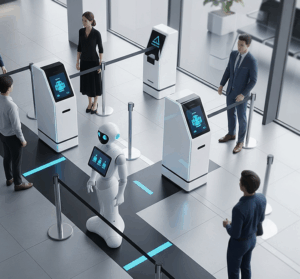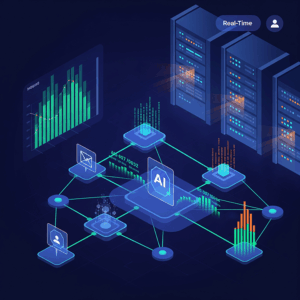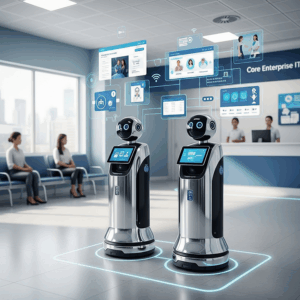
News & Updates

Guide to Robotic Queue Assistants
Robotic queue assistants are redefining customer experience in 2025, merging AI, automation, and real-time analytics to deliver seamless, secure, and responsive service. As organisations across healthcare, government, and finance sectors seek to streamline high- volume operations, robotic queue assistants stand out by reducing wait times, optimising resource allocation and creating frictionless journeys for every visitor. This guide explores the technological breakthroughs and real-world applications of robotic queue assistants, offering actionable insights for those aiming to lead in digital transformation and customer satisfaction. Whether you are a facilities manager, IT head, or service leader, understanding these innovations is crucial to building future-ready customer experiences that meet the ever- rising expectations of today’s users. Read on to discover the core functions, integration strategies, and measurable benefits of robotic queue assistants, and see how your organisation can harness this technology to drive operational excellence and service differentiation in 2025.
What Are Robotic Queue Assistants and How Do They Work?
Robotic queue assistants combine robotics, artificial intelligence, and smart sensors to revolutionise the way organisations manage customer flows and interactions. Unlike traditional queue systems, these intelligent solutions automate not just ticket issuance but also customer engagement, live status updates, and redirection within service environments. Through real-time monitoring and adaptive responses, robotic queue assistants are transforming peak volume management, reducing human error, and minimising the need for manual intervention at the front of house.
At the heart of these systems is a blend of physical and digital technology. Robotic queue assistants use embedded sensors to detect footfall and monitor queue lengths, while AI algorithms analyse live data to trigger timely interventions such as guiding visitors to available counters or providing estimated wait times. Touchscreen kiosks, mobile interfaces, and even humanoid robots work in concert, enabling customers to check in, receive information, and progress through their journey with minimal friction. By automating these routine tasks, organisations can focus staff resources on higher-value activities and deliver consistently smooth customer experiences, regardless of demand surges or operational challenges.
Core Functions and Technologies
Modern robotic queue assistants are powered by a sophisticated mix of machine learning, computer vision, and cloud integration. Machine learning algorithms continuously learn from historical and real-time data, predicting queue patterns and adapting resource allocation accordingly. Computer vision enables the system to recognise faces, read visitor badges, or monitor crowd density, supporting both security and efficiency objectives.
These assistants often integrate with touchscreen kiosks for ticketing and check-in, while mobile applications allow customers to monitor their queue status remotely. In advanced deployments, humanoid robots interact directly with visitors, answering questions and guiding them through facilities. Seamless connectivity with cloud platforms ensures that all customer interactions and queue data are synchronised across devices and locations, minimising manual intervention and supporting rapid scalability for organisations with multiple branches or service points.
Key Benefits for Businesses
By automating repetitive queue management tasks, robotic assistants help organisations achieve significant operational savings. Staff workload is reduced, allowing personnel to focus on complex or customer-sensitive matters rather than routine direction or ticketing.
Automation also increases accuracy, reducing the risk of manual errors that can lead to customer dissatisfaction or compliance issues.
Real-time analytics are a standout benefit, providing managers with up-to-the-minute visibility of queue lengths, service times, and bottlenecks. This enables dynamic allocation of staff and resources, ensuring optimal efficiency even during peak periods. Enhanced decision-making supports both immediate problem-solving and long-term process improvement, while the resulting improvements in service speed and customer satisfaction can translate into stronger loyalty and repeat business.
Real-World Applications Across Industries
The adoption of robotic queue assistants has surged across both public and private sectors in 2025, with organisations in healthcare, government, banking, and transportation leading the way. These intelligent systems are valued for their flexibility, compliance features, and ability to integrate with existing technology stacks, making them adaptable to a variety of operational contexts. Their impact is particularly evident in environments with high footfall and strict regulatory demands, where efficiency and security are paramount.
From streamlining patient check-ins in hospitals to automating citizen services in government offices, robotic queue assistants are setting new standards for operational excellence. These solutions not only reduce wait times and staff workload but also support inclusivity through multilingual interfaces and accessibility features. Integration capabilities ensure that robotic queue systems can work alongside legacy infrastructure, extending the value of prior technology investments while delivering measurable improvements in customer engagement and satisfaction.
Healthcare: Streamlining Patient Journeys
Hospitals and clinics have embraced robotic queue assistants to transform patient experience from the moment of arrival. These systems manage everything from registrations and appointment check-ins to way finding within complex facilities. AI-driven interfaces help to minimise congestion, ensuring that patients are directed efficiently and staff can focus on delivering quality care rather than managing queues.
Some healthcare institutions have reported up to a 30% reduction in average wait times since deploying robotic queue assistants (Frost & Sullivan, 2024). The automation of routine interactions frees up clinical staff, supports infection control with contactless processes, and enhances patient satisfaction by keeping them informed and engaged throughout their visit.
Government Services: Enhancing Public Access
In government service centres, robotic queue systems automate the flow of citizens handling tasks such as licensing, renewals, or consultations. These platforms not only manage high volumes efficiently but also support transparency and compliance by tracking every customer interaction and ensuring fair service order.
Multilingual capabilities are critical in serving diverse populations, with interfaces designed to accommodate various languages and accessibility needs. As a result, government agencies are able to deliver equitable and efficient services, reducing frustration and improving the public’s trust in digital government initiatives.
Retail and Banking: Personalising Customer Experience
Retail outlets and banks are leveraging robotic queue assistants to create more personalised and responsive customer journeys. These systems direct visitors to appropriate service counters, display real-time wait estimates, and offer tailored promotions based on customer profiles. By integrating with CRM systems, queue assistants can identify returning customers and present relevant offers or information, boosting conversion rates and fostering loyalty.
In banking environments, for example, robotic queue assistants ensure that high-value clients receive priority attention, while in retail, they can facilitate seamless transitions between online booking, in-store check-in, and payment. This integration of digital and physical touchpoints delivers a consistent and engaging experience that encourages repeat business.
Integration with Enterprise IT and Digital Platforms
The true power of robotic queue assistants emerges when they are seamlessly integrated with core enterprise IT and digital platforms. Modern organisations operate within complex ecosystems that include online resource booking systems, visitor management platforms, and payment solutions. By connecting queue assistants to these systems, organisations gain unified visibility, data-driven optimisation, and an elevated customer experience that spans both digital and physical channels.
Integration allows robotic queue assistants to do more than just manage lines; they can synchronise appointments in real time, automate visitor check-ins, enable secure payments, and deliver comprehensive analytics to managers. This unified approach reduces manual data entry, minimises errors, and ensures that each customer interaction is tracked and optimised. For businesses operating multiple sites, integrated platforms enable consistent service quality and operational oversight across all locations.
Connecting with Online Resource Booking Systems
Integrating robotic queue assistants with platforms such as ATT™’s Online Resource Booking System (ORBS) delivers a step-change in operational efficiency. Appointment data is synchronised in real time, allowing queue assistants to pre-allocate slots for visitors and guide them directly to the right service point upon arrival. This seamless flow reduces bottlenecks at check-in and ensures that resources are used optimally throughout the day.
With AI-driven scheduling intelligence, such as that offered by ATT’s ScheduleAI™ module, organisations can further refine appointment allocation based on historical demand patterns, staff availability, and service complexity. The result is a more predictable, efficient, and customer-friendly operation that minimises wait times and enhances satisfaction for both clients and staff.
Discover how ATT’s innovation-led, SaaS-enabled solutions can transform your visitor and online appointment management process. We have the ability to customise a solution to fit your unique operational needs. Contact us at infosoft- sales@attsystemsgroup.com and experience the impact of technology tailored to you.
AI and Data Analytics: The Engine Behind Intelligent Queuing
Artificial intelligence and data analytics are the driving forces behind the next generation of queue management. AI-powered robotic queue assistants do more than execute predefined rules; they learn, predict, and adapt in real time, transforming the way organisations handle fluctuating demand and deliver personalised service. These capabilities are essential for businesses seeking to optimise performance, maximise resource utilisation, and deliver superior customer experiences in 2025.
Through continuous analysis of historical and live data, AI models identify patterns in queue lengths, service times, and customer behaviour. This enables predictive resource allocation and proactive intervention, ensuring that bottlenecks are addressed before they escalate.
Data insights are also fed back into process improvement cycles, supporting a culture of continuous enhancement and measurable business value.
Predictive Queue Management
Predictive queue management uses AI models to forecast peak periods and recommend optimal staffing levels based on both historical trends and current data. By anticipating demand surges, robotic queue assistants can trigger pre-emptive actions such as opening additional service counters or reallocating personnel, reducing the likelihood of long waits or customer frustration.
Leading organisations have reported up to 40% reductions in queue lengths and improved service-level agreement (SLA) adherence by deploying predictive queue management tools (IDC, 2024). These improvements translate directly into higher customer satisfaction, more efficient use of resources, and enhanced reputation for service excellence.
Personalisation Through Data
Robotic queue assistants equipped with data analytics can recall individual preferences and anticipate customer needs based on previous interactions. In sectors like retail and banking, this enables tailored service recommendations, targeted promotions, and a more engaging experience for every visitor.
For example, a returning customer may be greeted by name, offered a preferred service package, or directed to their usual advisor. In healthcare, patients with specific needs can be prioritised or guided through bespoke care pathways. By leveraging these personalised touchpoints, organisations not only boost satisfaction but also unlock new upselling and loyalty-building opportunities.
Enhancing Accessibility, Security, and Compliance
As robotic queue assistants become central to service delivery in regulated industries, accessibility, security, and compliance have taken on new importance. Modern systems are designed to be inclusive, ensuring that all users, regardless of ability or background, can access services with ease. At the same time, robust data security measures and adherence to regulatory standards are built in, supporting organisations’ obligations to protect user privacy and operate transparently.
Adaptive interfaces and strong encryption are standard features, making robotic queue assistants a safe and reliable choice for sectors such as healthcare, government, and financial services. These solutions not only help organisations meet compliance requirements but also reinforce public trust by demonstrating a clear commitment to ethical and responsible technology deployment.
Universal Access and Multilingual Support
Touch-free kiosks, audio guidance, and multi-language options are essential components of accessible queue management. Robotic queue assistants deliver equitable service by accommodating users with disabilities and those who speak different languages, ensuring that no one is disadvantaged when accessing essential services.
This commitment to universal access is particularly important in public sector and healthcare deployments, where diverse user groups must be served fairly and efficiently. By removing barriers to entry and providing intuitive interfaces, organisations can improve overall service reach and satisfaction, strengthening their reputation as inclusive service providers.
Data Security and Regulatory Compliance
Processing sensitive personal data and payment information places strict demands on queue management systems. ISO-certified solutions, like those offered by ATT, incorporate advanced encryption, access controls, and detailed audit trails to ensure that data is protected at every stage of the customer journey.
These features are essential for meeting the requirements of regulations such as the Personal Data Protection Act (PDPA) and sector-specific standards. Automated compliance reporting, secure data storage, and proactive monitoring provide peace of mind for both organisations and their customers, establishing a foundation of trust that is vital for long-term digital transformation success.
Driving Next-Level Customer Experiences with Robotic Queue Assistants
Robotic queue assistants are transforming service delivery by combining automation, AI, and seamless integration with enterprise systems. Organisations that invest in these technologies are already realising measurable gains in efficiency, compliance, and customer satisfaction, positioning themselves as leaders in digital transformation for 2025 and beyond. As expectations continue to rise, adopting intelligent, accessible, and secure queue management will be key to staying ahead and delivering exceptional customer experiences in an increasingly connected world.
Contact us at infosoft- sales@attsystemsgroup.com and experience the impact of technology tailored to you.
Send us a message
Contact Information
Address:
35 Ubi Crescent, ATT Building, Singapore, 408585
Phone:
Email:
Website:
www.attsystemsgroup.com






